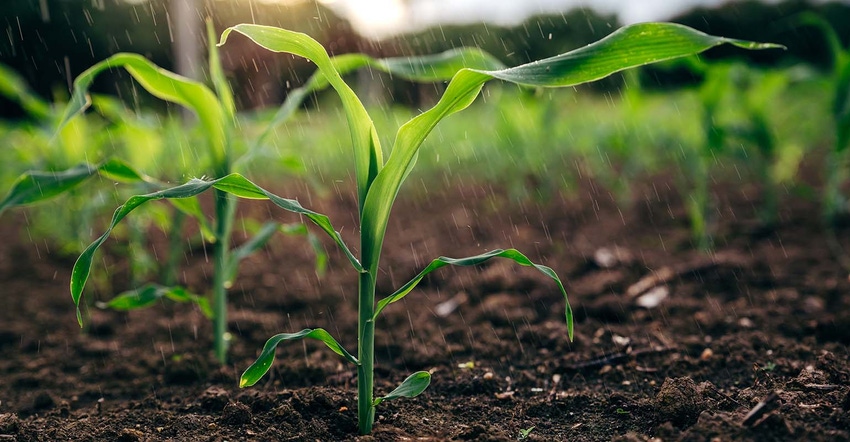
Ag markets tumbled Tuesday following a 3-day weekend in which traders returned to a cooler/wetter forecast versus the anticipated hot/dry forecast. Why?
Nearly every model excluding the European model suggested this cooler 10-day period, so it was hard to argue, and taking out weather premium was warranted. However, not all the models had much rain, ranging from 10-day totals of less than .03 to over 2.0” in the heart of the corn belt.
Everyone agrees that crops will fair relatively well in 10 days of cooler weather, even if rains are limited. But if the hot dome resurges in the following 10-18 days and rains disappoint, crop stress could develop quickly and weather price premium would likely occur.
So weather will no doubt be THE driving factor in the next four weeks. Producing a near-to-record crop is imperative to have enough supply to meet demand in the next year.
How to manage potential upside
Prices could be under $6 with record yields, and yet we could see well over $8 if the crop gets cooked.
The action point here seems obvious: watching weather and managing price risk is clearly the key to your marketing plan right now.
AgMarket.Net suggest being 50% sold with affordable calls bought against every bushel sold. Why are we doing this? If the market goes to $8, the sales we made at $6.50 might be worth $7.50 if we liquidated the calls we bought and add the proceeds to our sale. Not bad!!
Everyone’s prices will work out differently depending on which option they buy, but it essentially allows us to take advantage of selling that same bushel twice if the market goes up. If the market declines, our grain is protected less the cost of the option. So for example, If we sold at $6.50 and the market goes to $5.50, we would only lose the 20-cent premium we paid so our net would be $6.50-.20 = $6.30 net.
We would also like to bump up the percentage sold as the calendar turns beyond July 4. Hopefully that will be at a higher price. Weather will dictate that.
Fed inflation policy could weigh on prices
There is another thing that is dictating price direction: Federal Reserve fiscal policy. You need to be aware of how this policy could impact grain prices.
After the Great Recession in 2008, the Fed lowered interest rates to encourage economic growth. It just started to raise rates when covid hit. With a work shut down threatening the economy, the Feds reversed course and pulled every card called QE (Quantitative Easing), and provided income stimulus, which caused inflation to move higher.
Now inflation is running beyond desired levels. Like an uncontrolled horse running for the barn, there seems to be no real good way to end this ride. The Fed is raising rates, tapering bond purchases, and shifting that bond purchasing demand to the private sector. And to get Grandma and Grandpa to buy municipal bonds again -- they want to make more than 1.5% -- rates will keep going up until Grandma says buy bonds.
Interest rates on loans will go up until the economic investment slows, which cuts demand on goods, and causes prices to eventually go down. Then, in theory at least, inflation will drift lower to the levels the feds want. And when that happens, your grain prices will also go down as the speculative investor who bought commodities as an inflation hedge calls his broker and says sell out, I don’t need an inflation hedge anymore because the Fed's policy calls for 2% inflation, not +7%.
This policy is very important to understand because it means the price of your commodities will be in a down trend. Eventually. Regardless of a short crop and an extreme high price that kills exports or simply because it rained and we have a bigger supply.
This policy should get you thinking about selling grain multiple years out. We already said buy a risk reversal long put and sell a call in March 23 short dates options against 50% of your 2023 production as an insurance hedge. Cost was from 5 to 20 cents depending on what the client wanted to do. We will do more if prices rally. We will do more if 2022 weather is crop favorable.
Bottom line, we know this market is likely going to top this year. Hopefully the state next to you has a weather problem, and we sell at a higher price. But we know high enough prices will kill demand eventually and top the market.
Maybe we get good weather everywhere and we have to sell lower. But in addition to the natural top that will occur in our Ag markets, there is a fiscal policy now in play that is deflationary, dis-inflationary, stagflationary, non-inflationary -- pick the word you want to use. None of those terms are bullish to corn once we determine the next few weeks of weather.
Reach Bill Biedermann at 815-893-7443 or [email protected].
The risk of loss in trading futures and/or options is substantial and each investor and/or trader must consider whether this is a suitable investment. AgMarket.Net is the Farm Division of John Stewart and Associates (JSA) based out of St Joe, MO and all futures and options trades are cleared through ADMIS in Chicago IL. This material has been prepared by an agent of JSA or a third party and is, or is in the nature of, a solicitation. By accepting this communication, you agree that you are an experienced user of the futures markets, capable of making independent trading decisions, and agree that you are not, and will not, rely solely on this communication in making trading decisions. Past performance, whether actual or indicated by simulated historical tests of strategies, is not indicative of future results. Trading information and advice is based on information taken from 3rd party sources that are believed to be reliable. We do not guarantee that such information is accurate or complete and it should not be relied upon as such. Trading advice reflects our good faith judgment at a specific time and is subject to change without notice. There is no guarantee that the advice we give will result in profitable trades. The services provided by JSA may not be available in all jurisdictions. It is possible that the country in which you are a resident prohibits us from opening and maintaining an account for you.
The opinions of the author are not necessarily those of Farm Futures or Farm Progress.
About the Author(s)
You May Also Like






